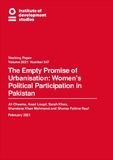The Empty Promise of Urbanisation: Women’s Political Participation in Pakistan
| dc.contributor.author | Cheema, Ali | |
| dc.contributor.author | Liaqat, Asad | |
| dc.contributor.author | Khan, Sarah | |
| dc.contributor.author | Khan Mohmand, Shandana | |
| dc.contributor.author | Rauf, Shanze Fatima | |
| dc.coverage.spatial | Pakistan | en |
| dc.date.accessioned | 2021-02-11T12:30:18Z | |
| dc.date.available | 2021-02-11T12:30:18Z | |
| dc.date.issued | 2021-02-11 | |
| dc.identifier.citation | Cheema, A.; Liaqat, A.; Khan, S.; Khan Mohmand, S. and Rauf, S.F. (2021) The Empty Promise of Urbanisation: Women’s Political Participation in Pakistan, IDS Working Paper 547, Brighton: Institute of Development Studies, DOI: 10.19088/IDS.2021.021 | en |
| dc.identifier.isbn | 978-1-78118-770-8 | |
| dc.identifier.issn | 2040-0209 | |
| dc.identifier.uri | https://opendocs.ids.ac.uk/opendocs/handle/20.500.12413/15949 | |
| dc.description.abstract | Do big cities enable or hinder women’s electoral participation? What are the determinants of women’s participation in big cities and how are they different from those in rural areas? We use the Election Commission of Pakistan’s novel gender-disaggregated constituency level data set for the 2018 elections to answer these questions in the context of Pakistan, a country that has seen rapid urbanisation and today hosts 14 big cities with populations of over half a million people. Contrary to expectations, we find that women’s electoral participation is 8.5 per cent lower in big cities compared to rural areas and this is mirrored by a higher gender gap in participation in this context. In big cities we do not find support for theories that suggest women’s increased political participation is linked to a fall in the burden of care work, an increase in women’s intra-household bargaining power, and their entry into the paid labour force. The gender gap in political participation is higher in big cities even though city women do much better on all these indicators compared to their rural counterparts. We do, however, find a positive association between education and women’s political participation in big cities. We use data from the Herald-SDPI national opinion poll conducted in the run up to the 2018 elections to show that women’s lower electoral participation in cities is mirrored by more tenuous linkages between them and political parties compared to linkages in rural areas. This evidence suggests that weak engagement between political parties and women voters may be an important channel explaining women’s lower electoral participation in cities. We also find that women’s political participation is lower in big cities with greater exposure to political violence. | en |
| dc.description.sponsorship | Foreign, Commonwealth & Development Office | en |
| dc.language.iso | en | en |
| dc.publisher | Institute of Development Studies | en |
| dc.relation.ispartofseries | IDS Working Paper;547 | |
| dc.rights | This is an Open Access paper distributed under the terms of the Creative Commons Attribution 4.0 International licence (CC BY), which permits unrestricted use, distribution, and reproduction in any medium, provided the original authors and source are credited and any modifications or adaptations are indicated. | en |
| dc.rights.uri | http://creativecommons.org/licenses/by/4.0/ | en |
| dc.subject | Gender | en |
| dc.subject | Participation | en |
| dc.subject | Politics and Power | en |
| dc.title | The Empty Promise of Urbanisation: Women’s Political Participation in Pakistan | en |
| dc.type | IDS Working Paper | en |
| dc.rights.holder | Institute of Development Studies | en |
| dc.identifier.team | Power and Popular Politics | en |
| dc.identifier.doi | 10.19088/IDS.2021.021 | |
| rioxxterms.funder | Default funder | en |
| rioxxterms.identifier.project | Default project | en |
| rioxxterms.version | VoR | en |
| rioxxterms.versionofrecord | 10.19088/IDS.2021.021 | en |
| rioxxterms.funder.project | 9ce4e4dc-26e9-4d78-96e9-15e4dcac0642 | en |
Files in this item
This item appears in the following Collection(s)
Except where otherwise noted, this item's license is described as This is an Open Access paper distributed under the terms of the Creative Commons Attribution 4.0 International licence (CC BY), which permits unrestricted use, distribution, and reproduction in any medium, provided the original authors and source are credited and any modifications or adaptations are indicated.


